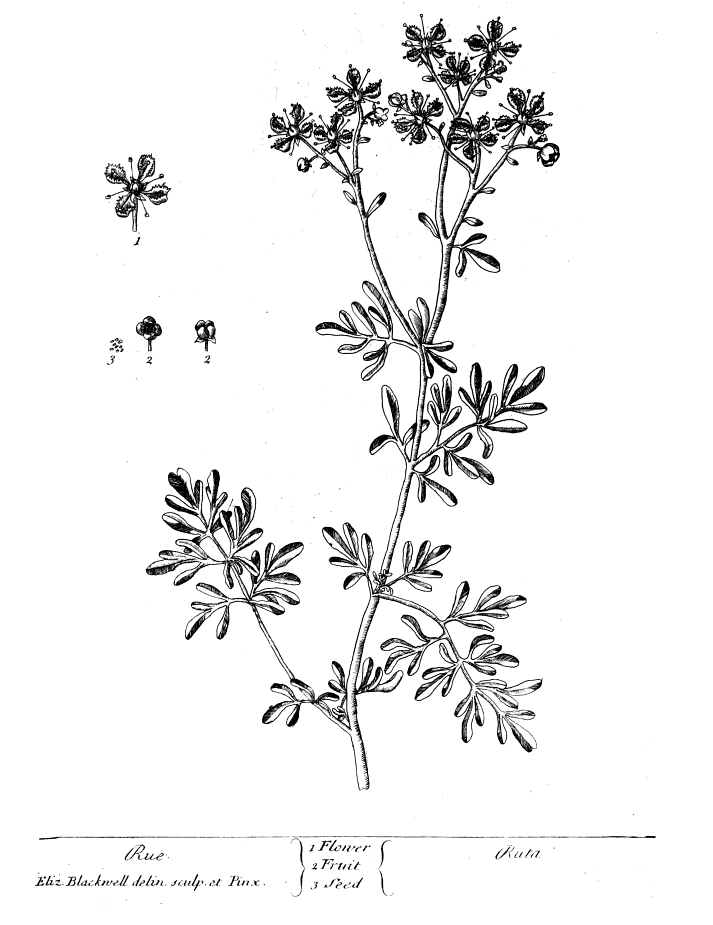Rue

Note - Rue has some toxicity reports. See scientific studies (below) for details.
Other names for Rue, Past or Present
Latin - Ruta graveolens - also Ruta, Ruta hortensis, Ruta hortensis major, Ruta graveolus, Ruta
hortensis, latifolia. B. P. 336. 'T. 257. Ruta graveolens, hortensis. Dod. 119. Ruta sativa, vel hortensis. J. B. iij. 197. R. H.
874. Ruta hortensis. Ger. 1255. Ruta hortensis major. Park. 132. Ruta hortensis major, latifolia. H.Ox. it. 507. Ruta, foliis
decompositis. H. Cliff. 145.
English - Common Rue, Garden Rue, Herb-of-Grace
Spanish - Aruda
Latin - Ruta
Italian - Ruta
French - Rut
German - Rauten, Beincraut
Dutch - Ruyte
Rue - Overview
Rue is a hardy type of evergreen shrub that can be easily grown from seed or from cuttings. It was used by indigenous peoples of North America as an insect repellent. The leaves and stems of the Rue plant contain strong bitter oils that can cause the skin to become irritated when exposed to direct sunlight. [1]
Although the leaves are often used to add flavor to salads, cheeses, and beverages (as bitters), over-consumption of Rue can cause severe stomach upset. When taken in moderate doses, Rue is considered a blood-strengthening herb. [2]
Wild rue grows on the hillsides of Southern Europe and is stronger in scent than the cultivated varieties. [2] In North America, it was used by indigenous peoples as insect repellent. [3]
Rue - Scientific Studies And Research
Contact with rue has been found to cause skin rashes, excema and dermatitis when combined with direct sunlight. The condition produced by these factors is called Phytophototoxicity, a type of photocontact dermatitis. [2] According to a 2007 study, Phytophototoxicity is different from the type photocontact dermatitis caused by allergic reaction (allergic photocontact dermatitis occurs only in individuals with a known allergy to Rue). Although the factors that result in phytophototoxicity are more complex than that of allergic photocontact dermatitis, cases of phytophototoxicity are reported more frequently.
Rue (Ruta graeolens) has recently (2011) been studied for its potential to inhibit the production and survival or cancer cells. [3] To test its anticancer properties, extract of Rue was tested on colon, breast and prostate cancer cells. Researchers determined that extract of Rue contains bioactive compounds which can potentially inhibit cancer cell production and survival.
In a recent (2011) study, Rue (Ruta) was examined for potentially toxic properties. Researchers found that ingestion of rue might produce a significant side effect (Toxic Hepatitis) in certain individuals. At the time of the findings, this potential complication had not been recorded in the existing documentation concerning the use of Rue for treatment purposes. [5][6]
Preethi, Kuttan, and Kuttan (2006) explored the antitumor activity of rue (Ruta graveolens) in ascites and solid tumor models and its possible mechanisms of toxicity. The results from this study concretely demonstrated the cytocidal action of rue extract as well as its ability to reduce tumors. To expound on this further, a remarkable cytotoxic effect against Dalton's lymphoma ascites, Ehrlich ascites carcinoma, and L929 cells in culture (IC100 of 16 mg/mL) and a consequent increase in the lifespan of experimental animals with tumors were noted. Not only that, a decrease in the development of solid tumors was observed as a result of rue extract administration. Rue extract seemed to have scavenged the hydroxyl radicals and inhibited the peroxidation of lipids at low concentrations. [7]
Rue also appears to possess positive chronotropic and inotropic effects, as illustrated by Chiu and Fung (1997) who investigated the cardiovascular actions of the common rue at the tissue level in vitro. In this study, when given in combination with green beans and kelp, a dose-related subtractive effect on atrial rate decrease was detected, and when given along with kelp only, rue exerted a relaxation effect on KCl preconstricted rat tail artery strips. [8] Ratheesh, Shyni, Sindhu, and Helen (2011) on another note proposed rue's potential for the therapeutic management of atherosclerosis-associated clinical conditions due to its efficacy in reducing oxidative stress, inflammation, and aortic pathology in hypercholesteremic rats. Upon treatment with rue methanolic extract for 90 days, experimental rats exhibited decreased levels of total cholesterol and low-density lipoprotein cholesterol and increased level of high-density lipoprotein cholesterol; increased antioxidant enzyme activities; and decreased myeloperoxidase, cyclooxygenase-2, and 15-lipoxygenase activities. [9]
Aside from its anticancer and cardiovascular properties, rue also significantly inhibits two important proinflammatory mediators, namely, nitric oxide and prostaglandins, hence the potent anti-inflammatory action of rue. [10]
A few studies have also looked into rue's potential as a male contraceptive herb. For instance, Sailani and Moeini (2007) injected adult male rats intraperitoneally with Ruta graveolens and Cannabis sativa 5% ethanol extracts at a dose of 20 mg/day for 20 days to evaluate the effects of the said extracts on spermatogenesis. This study had showed that the ethanol extracts derived from R. graveolens and C. sativa significantly diminished the number of sperms in the treatment group, but the group on R. graveolens extract treatment manifested far better results (i.e., more reduced spermatogenesis) than the group on C. sativa extract treatment. [11] Harat, Sadeghi, Sadeghipour, Kamalinejad, and Eshraghian (2008) described rue as a "new male channel blocker contraceptive" because of its sperm immobilization effects. In their study, at different doses, lyophilized aqueous extract of rue immediately immobilized the sperms in fresh semen dose-dependently, rendering all sperms immobile at a concentration of 100 mg/mL. [12]
Rue - Phytochemistry / Active Components
The extract from the leaves of rue has been demonstrated to contain a wide range of compounds, including furanocoumarins, quinoline alkaloid, and quinolone alkaloids. All of these are fungicides or antifungal compounds and have a moderate activity against Fusarium oxysporum and a high activity against Phomopsis viticola, whereas a few of these alkaloids are moderately active against Colletotrichum . The novel compound 1-methyl-2-[6'-(3' ',4' '-methylenedioxyphenyl)hexyl]-4-quinolone yielded from rue leaves was found to be highly active against Botrytis cinerea. [13] Moreover, various glycosides, namely, 3'-sinapoyl-6-feruloylsucrose, methylcnidioside A, methylpicraquassioside A, 3',6-disinapoylsucrose, cnidioside A, rutin, and picraquassioside A, can be isolated from the ethanolic extract of Ruta graveolens aerial parts. [14]
Rue - History
It was suggested by Dioscorides that the seeds of Rue should be consumed with wine to protect against the bites of serpents, scorpions and hornets. [2]
It was stated by Hippocrates that leaves of Rue should be ground with
roasted linseed and leaves green marjoram and prepared as a plaster for
inflammation and swelling in the areas around legions.
(Hippocrates: Volume VIII)
Mithredates described Rue as an antidote to protect against infection.
[15]
Rue was commonly used as a "cure" during the plague.[2]
In Aristotle's day, common (cultivated) Rue was worn around the neck to protect one from evil spirts and witches' curses. Its alternative name, Herb-of-Grace, was coined by early Christians in the Middle Ages who used it to perform exorcisms. During the Middle Ages, Rue was administered by midwives as a contraceptive and to induce abortion.
Italian Renaissance painters consumed leaves of Rue to prevent eye-strain.
In The Healing Art: Or, Chapters Upon Medicine, Diseases, Remedies and Physicians (1887), William Henry Davenport Adams explains how the business of healing in England in his day was dominated by "wise woman" who, --with a suspiscion of witchcraft, or, at least, of uncanniness, clinging to her--who concocted all kinds of potions and infusions which then formed the people's pharacop≈"a. Davenport Adams clearly defines the methods of the "wise woman" as separate from "the Healing Art," asserting that the plants "relied upon [by] herbalists and herb-doctors who obtain a scanty livelihood in obscure corners of our cities, and the gossops who still, in some of our villages, boast of their remedies for wounds and bruises, rheumatism and other bucolic ills" were dangerous or otherwise ineffective (1887:175).
Established alternative treatments such as homeopathy, as well as the folk treatments performed by these wise women (for which the use of herbs like Rue was essential) were considered by Davenport Adams to be quackery.
Rue is mentioned in Shakespeare's Hamlet and Richard II. and was also mentioned by Dioscorides, Hippocrates, Mithridates, Turner (1562)
Rue in old Herbals & Pharmocopœia
Elizabeth Blackwell's "A Curious Herbal" (1751): 1. The leaves are a Willow-green, and the Flowers yellow; the Stalks grow about two Foot high. 2. It is planted in Gardens, and flowers in Iune and Iuly. 3. The Leaves and Seed are used, benig esteem'd alexipharmic, good against all infections and pestilential Diseases, and all kind of Fevers; it eases Disorders of the Head, Nerves, Womb, convulsion and Histeric Fits, the Collick, Weakness of the Stomach and Bowels, it repells Poison, and lures the Bite of venemous [sic] Creatures and mad Dogs. It is an Ingredient in the Aqua Brion. comp. [Bryony water extracted with alcohol [1]] and the Aqua Theriacalis. The officinal preparations are the Simple Water, Conserve of the Leaves, and an oil by Decoction.
William Thomas Fernie - "Herbal Simples" (1895): The wild Rue is found on the hills of Lancashire and Yorkshire, being more vehement in
smell and in operation than the garden Rue. This latter, Buta gravcolens (powerfully redolent), the common cultivated Rue of our kitchen gardens, is a
shrub with a pungent aromatic odour, and a bitter, hot, penetrating
taste, having leaves of a bluish-green colour, and remaining verdant all the year round. It is first mentioned as cultivated in England by Turner, in
his Herbal, 1562, and has since become one of the best known and most widely grown Simples for medicinal and homely uses. The leaves are so acrid, that if they be much handled they inflame the skin; and the wild plant
possesses this acridity still more strongly.
Water serves to extract the virtues of the cultivated shrub, better than spirit of wine is able to do. The juice of Rue is of great efficacy in some
forms of epilepsy, operating for the most part insensibly, though sometimes causing vomiting or purging. If a leaf or two of Rue be chewed, a
refreshing aromatic flavour will pervade the mouth, and nervous headache, giddiness, hysterical spasm, and palpitation, will be quickly relieved. Two
drachms of powdered Rue, if taken every day regularly as a dose for a long while together, will often do wonders. It was much used by the ancients,
and Hippocrates commended it. Mithridates also considered it able to resist poisons, and to expel them when taken ; but this notion became afterwards
exploded. The herb is strongly stimulating and antispasmodic; its most important constituent being the volatile oil, which contains caprinic, pelargonic, caprylic, and
œnantbylic acids. The oxygenated portion is caprinic aldehyde. In too full doses the oil causes aching of the loins, frequent urination, dulness
and weight of mind, flushes of heat, unsteadiness of gait, and increased frequency of the pulse, but with diminished force. Similar symptoms are
produced during an attack of the modern epidemical influenza, as likewise by oil of wormwood, and some other essential oils.
Externally, Rue is an active irritant to the skin, causing a pustular eruption. It stimulates the monthly function in women, but must be used with
caution.
The decoction and infusion are to be made from the fresh plant, or (when this plant cannot be got) the oil may be given in a dose of from one to five
drops. Externally, compresses saturated with a strong decoction of the plant, when applied to the chest, have been used beneficially for chronic
bronchitis.
Rue is best adapted to those of phlegmatic habit and of languid constitutional energies. It is often employed in the form of tea. The Schola
Saternitana [i.e. the 'Regimen Sanitatis Salernitatum'] says about this plant:—
"Ruta viris minuit venerem, mulieribus addit;
Ruta facit eastum, dat lumen, et ingerit artum
Coctaque ruta facit de publicibus loca tuta."
The leaves promote the menses, being given in doses of from fifteen to twenty grains. "Pliny," says John Evelyn, "reports Rue to be of such effect for
the preservation of sight, that the painters of his time used to devour a great quantity of it; and the herb is still eaten by the Italians frequently
mingled amongst their salads." With respect to its use in epilepsy, Julius Caesar Baricellus said: "I gave to my own children two scruples of the
juice of Rue, and a small matter of gold; and, by the blessing of God, they were freed from their fits." The essential oil of Rue may be used for the
same purpose, and in like manner.
Formerly this plant was thought to bestow second sight; and so sacred a regard was at one time felt for it in these islands, that the missionaries
sprinkled their holy water from brushes made of the Rue; for which cause it was named "Herb of Grace."
Gerard tells us: "The garden Rue, which is better than the wild Rue for physic's use, grows most profitably (as Dioscorides said) under a fig
tree."
"The herb, a little boiled or scalded, and kept in pickle as is samphire, quickens the sight. But the wild Rue venometh the hands that touch it; and
will also infect the face; therefore, it is not to be admitted to meat or for medicine." The leaves of Rue are curative of croup in poultry. In the
early part of the present century it was customary for judges, sitting at assize, to have sprigs of Rue placed on the bench of the dock, as defensive
against the pestilential infection brought into court from gaol by the prisoners. The herb was supposed to afford powerful protection from
contagion.
At the present time the medicinal tincture is used for the treatment of rheumatism, when developed in the membranes which invest the bones.
If bruised and applied, the leaves will ease the severe pain of sciatica. The expressed juice taken in small quantities is a noted remedy for nervous
nightmare. A quaint old rhyme says of the plant:—
"Nobilis est ruta quia lumina reddit acuta."
As a preserver of chastity Ophelia was made by Shakespeare to give Rue to Hamlet's mother, the Queen of Denmark.
Charles Alston - "Lectures on the materia medica: containing the natural history of drugs" (1770):
Common or Garden-Rue; by some Herb-of-grace. It grows in Spain, etc. In gardens
it flowers in June. The leaves, flowering tops, and fruit, or feeds with
their feed-vessels, are used...It is antacid, acrid, detergent, diaphoretic and
diuretic, powerfully dissolving as well as stimulating, called alexipharmic,
cephalic, nervine and uterine; and is commended internally in malignant fevers,
pestilence, poisons, bites of mad dogs, serpents, &c. in cachexies, scurvies,
agues, palsies, epilepsies, palipitatio cordis, vapours, melancholy, worms,
&c. and outwardly, for pains, inflammations, tumors, gangrenes, &c.
The fresh herb may be given, or its juice, with wine &c. or used like tea...
well-rubbed with sugar and diluted.
Rue - image

Rue
References:
[1] https://www.british-history.ac.uk/report.aspx?compid=58687
[2] Elkhorst, Kimberley, Vincent DeLeo and Joan Csaposs. 2007. Rue the Herb: Ruta graveolens--Associated Phytophototoxicity In Dermatitis 18(11): Pp. 52-55.
[3] Fadlalla K, Watson A, Yehualaeshet T, Turner T, Samuel T. 2011. Ruta graveolens extract induces DNA damage pathways and blocks Akt activation to inhibit cancer cell proliferation and survival In Anticancer Research 31(1): Pp 233-41.
[4] Garland, Sarah. The Complete Book of Herbs and Spices. 1979. Francis Lincoln Limited:London.
[5] https://www.alchemy-works.com/herb_rue.html
[6] Rabaev E, Zeller L, Biton A, Barski L. 2011. Toxic Hepatitis Due to the Use of Ruta Herbal Medicine. In Harefuah [Article in Hebrew]. 150(3): Pp 235-6, 305.
[7] Preethi K. C., Kuttan G., & Kuttan R. (2006). Anti-tumour activity of Ruta graveolens extract. Asian Pacific Journal of Cancer Prevention, 7(3): 439-443. Retrieved 25 March 2013 from https://www.ncbi.nlm.nih.gov/pubmed/17059340
[8] Chiu K. W. & Fung A. Y. (1997). The cardiovascular effects of green beans (Phaseolus aureus), common rue (Ruta graveolens), and kelp (Laminaria japonica) in rats. General Pharmacology, 29(5): 859-862. Retrieved 25 March 2013 from https://www.ncbi.nlm.nih.gov/pubmed/9347338
[9] Ratheesh M., Shyni G. L., Sindhu G., & Helen A. (2011). Inhibitory effect of Ruta graveolens L. on oxidative damage, inflammation and aortic pathology in hypercholesteromic rats. Experimental and Toxicologic Pathology, 63(3): 285-290. doi: 10.1016/j.etp.2010.01.007. Retrieved 25 March 2013 from https://www.sciencedirect.com/science/article/pii/S0940299310000084
[10] Raghav S. K., Gupta B., Agrawal C., Goswami K., & Das H. R. (2006). Anti-inflammatory effect of Ruta graveolens L. in murine macrophage cells. Journal of Ethnopharmacology, 104(1- 2): 234-239. Retrieved 25 March 2013 from https://www.sciencedirect.com/science/article/pii/S0378874105006185
[11] Sailani M. R. & Moeini H. (2007). Effect of Ruta graveolens and Cannabis sativa alcoholic extract on spermatogenesis in the adult Wistar male rats. Indian Journal of Urology, 23(3): 257-260. Retrieved 25 March 2013 from https://europepmc.org/articles/PMC2721602/
[12] Harat Z. N., Sadeghi M. R., Sadeghipour H. R., Kamalinejad M., & Eshraghian M. R. (2008). Immobilization effect of Ruta graveolens L. on human sperm: a new hope for male contraception. Journal of Ethnopharmacology, 115(1): 36-41. Retrieved 25 March 2013 from https://www.ncbi.nlm.nih.gov/pubmed/18029123
[13] Oliva A. et al. (2003). Natural fungicides from Ruta graveolens L. leaves, including a new quinolone alkaloid. Journal of Agricultural and Food Chemistry, 51(4): 890-896. Retrieved 25 March 2013 from https://www.ncbi.nlm.nih.gov/pubmed/12568545
[14] Chen C. C., Huang Y. L., Huang F. I., Wang C. W., & Ou J. C. (2001). Water-soluble glycosides from Ruta graveolens. Journal of Natural Products, 64(7): 990-992. Retrieved 25 March 2013 from https://www.ncbi.nlm.nih.gov/pubmed/11473445
[15] JAMA: The Journal of the American Medical Association. Vol. 24. 1895.
Main article researched and created by Kelsey Wambold, additional scientific studies by Dan Ablir.
© herbshealthhappiness.com


1. Famous Chef Sheds 60lbs Researching New Paleo Recipes: Get The Cookbook FREE Here
2. #1 muscle that eliminates joint and back pain, anxiety and looking fat
3. Drink THIS first thing in the morning (3 major benefits)
4. [PROOF] Reverse Diabetes with a "Pancreas Jumpstart"
5. Why Some People LOOK Fat that Aren't
6. Amazing Secret Techniques To Protect Your Home From Thieves, Looters And Thugs
7. The #1 WORST food that CAUSES Faster Aging (beware -- Are you eating this?)
If you enjoyed this page:



























